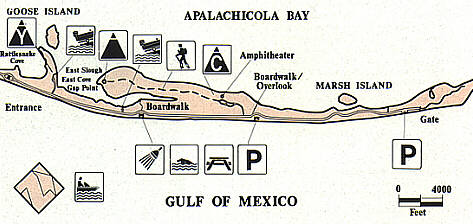St. George Island State Park Nine miles of undeveloped beaches and dunes, surrounded by the Gulf of Mexico and Apalachicola Bay, provide the perfect setting for St. George Island State Park. Occupying 1,962 acres at the end of a long, narrow barrier island, St. George is a combination of sandy coves, salt marshes, shady pines and oak forests. During most of its 5,000 years of existence, St. George Island was uninhabited by man. During the early and middle 1900s, the island's pine forests were turpentined. Many scars are still visible on the island's larger slash pines. During World War II, the island was used by troops for numerous training exercises that were carried out over the area's vast dunes. Acquisition of land for the park in 1963 and completion of the causeway in 1965 led to increased use of the beaches for recreational activity. In 1980, construction of the park facilities was complete, and the park was opened for public use. The natural features of the park include extensive beaches and dunes, forests of slash pines and live oak hammocks. The ocean and bay support an abundance of marine life, while small freshwater ponds and sloughs provide a limited aquatic habitat in an otherwise arid climate. The waters of this area are some of the most productive commercial and sport fisheries in Florida, with a thriving oyster industry at the mouth of the Apalachicola River. The arid conditions, coupled with the park's island location, limit both the number and type of resident animal life. Osprey may frequently be seen fishing in the waters, and their nests are found in the tops of living or dead pine trees in the park. Raccoons and ghost crabs may be observed, along with the salt-marsh snakes and diamondback terrapin that reside in the marsh and bay waters. Birds such as the snowy plover, least tern, black skimmer, willet and many other species of shorebirds frequently nest alond the park's sandy shores and grass flats. The barrier islands of the Gulf Coast are important rest stops for a wide variety of migrating birds during the fall and spring. The best time to observe migrating birds is after the passage of cold fronts. Real Fun in the Real Florida
|
|||

| Many thanks to another of our fine sponsors:Pirate's Cove Marina |
